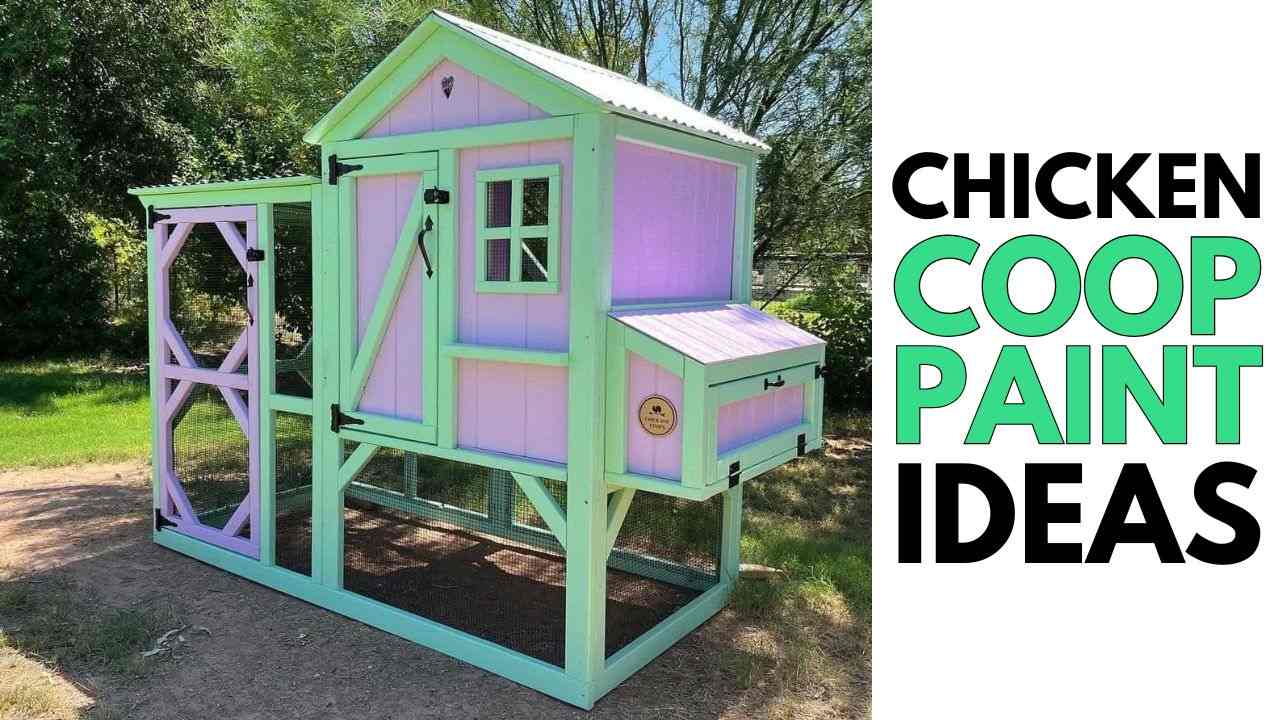Did you know a well-painted chicken coop can last up to 10 years longer than an unpainted one?
Yet, many backyard chicken keepers struggle with finding the right paint, safe for their flock, durable against weather, and stylish enough to brighten their backyard.
Painting your chicken coop isn’t just about looks. It’s about creating a safe, healthy environment for your chickens.
Remember using the wrong paint can harm your chickens. Chickens are sensitive to toxins and paints with high levels of VOCs (Volatile Organic Compounds) can cause respiratory issues.
That’s why choosing non-toxic, low-VOC paints is crucial.
In this article, we’ll explore creative, safe paint ideas for transforming your coop into a stunning backyard centerpiece.
Why Paint Your Chicken Coop?
Let’s examine the reasons why painting your chicken coop is a must and provide some practical tips to get you started.
- Protect the Wood from Weather Damage
Paint prevents water from seeping into the wood, reducing the risk of mold and mildew. UV-resistant paints keep the wood from fading and cracking under the sun.
- Make Cleaning Easier
Paint creates a sealed surface that’s easy to wipe down. Some paints, like ECOS Pet Dwelling Paint, are specifically designed to resist mold, keeping your coop fresh and clean.
- Keep Your Chickens Healthy
Opt for zero-VOC paints like The Real Milk Paint Co. or ECOS Paints, which are free from harmful chemicals and safe for animals. Always allow the paint to dry completely (usually 24-48 hours) before letting your chickens back into the coop to avoid exposure to fumes.
- Deter Pests and Parasites
White or pastel shades reflect light and make pests more visible. Painted walls leave fewer crevices for pests to hide in.
- Improve Insulation and Temperature Control
Use light colors like white or pastel blue to reflect sunlight. Darker colors like barn red can help retain heat during colder months.
- Add Aesthetic Appeal
Popular combinations include red with white trim or light blue with gray accents. Add patterns or murals to make your coop unique.
- Increase Durability and Longevity
Choose high-quality exterior paints like BEHR Barn Paint or Rust-Oleum Enamel Paint for long-lasting protection. Repaint every 2-3 years to maintain the protective layer.
- Fun Fact
Did you know that red is the most popular color for chicken coops? Historically, farmers used red paint mixed with rust to kill mold and moss on wood.

Popular Color Combinations for a Chicken Coop
Choosing the right color combination for your chicken coop is a blend of practicality and creativity. Here are the top 5 popular color combinations for your chicken coops.
- White with Black Trim
This classic combination is timeless and elegant. White reflects heat, while black trim adds a sleek contrast. It’s best for modern or minimalist garden designs.
- Red with White Trim
Red is a traditional barn color that’s thought to attract hens and encourage egg-laying. Paired with white trim, it creates a rustic, farmhouse look. It’s best for those aiming for a classic, old-fashioned aesthetic.
- Light Gray with White Trim
Light gray is neutral and hides dirt well, while white trim brightens the appearance. It’s a good option for urban or suburban settings.
- Pastel Blue with White Trim
Pastel blue is calming and adds a cheerful touch to your backyard. It also reflects sunlight, keeping the coop cool. It’s best for families or those who want a playful, vibrant look.
- Natural Wood Stain with Green Accents
Wood stains like cedar or brown offer a natural, earthy feel. Adding green accents helps the coop blend into the garden. It’s best for eco-conscious homeowners or those with a rustic garden theme.

Exterior Chicken Coop Paint Ideas
Choosing the right color is key to creating a stunning coop. Here are some popular options for the exterior of the coop.
- Classic Barn Red
This timeless color gives your coop a rustic, farmhouse look. It’s also practical, as it hides dirt and mud well. Pair it with, white trim for a clean, traditional finish.
- Earthy Neutrals
Colors like brown, beige, and olive green blend seamlessly with natural surroundings, making your coop feel like part of the landscape. Pair it with wooden accents for a natural, organic vibe.
- Bright Pastels
Shades like mint green, baby blue, or soft yellow add a playful touch and brighten up your backyard. Pair it with, white or gray trim for a modern, cheerful look.
- White
White reflects sunlight, keeping the coop cooler in summer. It also makes it easier to spot mites and other pests. Pair it with bold accents like red or blue for a striking contrast.
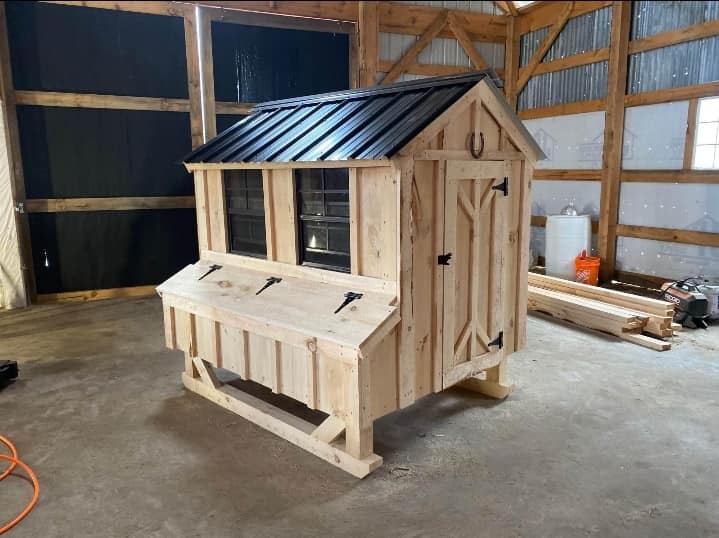
Interior Chicken Coop Paint Ideas
Here are some of the best colors for interior coops:
- White
It brightens the space, making it easier to spot mites and other pests. It also reflects light, creating a cheerful environment for your chickens.
- Light Green or Blue
These colors are calming and serene and also reduce stress in chickens. It’s perfect for creating a peaceful atmosphere.
- Rusty Red or Orange
These encourage egg-laying by mimicking the warmth of daylight. It also adds a cozy, rustic feel to the coop.

How to Paint Your Chicken Coop
- Choose the Right Paint
The most important step is selecting a non-toxic, water-based paint that’s safe for chickens. Avoid paints with VOCs (Volatile Organic Compounds), as these can harm your chicken.
- Prepare the Coop
Before painting, you need to prepare the coop properly:
Remove dirt, cobwebs, and old paint using a brush or pressure washer. Let it dry completely.
Use 80-120 grit sandpaper to smooth rough areas. This helps the paint stick better.
Fix any cracks or holes in the wood to ensure a smooth finish.
- Apply Primer (If Needed)
If you’re painting bare wood or a dark surface, apply a primer first. Use a non-toxic primer like ECOS Pet Dwelling Primer.
- Paint the Coop
Now comes the fun part! Follow these tips for a smooth finish:
#1 Use the right tools like a brush or roller, which works best for large areas, while a small brush is ideal for corners and edges.
#2 Apply thin coats, start with a thin layer of paint, and let it dry completely before adding a second coat. This prevents drips and ensures even coverage.
#3 Focus on the exterior, while painting the inside is optional, it’s a good idea to paint the roosting bars and nesting boxes for easier cleaning.
Tip: Paint in dry weather with temperatures between 50°F and 80°F for the best results.
- Let It Dry Completely
After painting, let the coop dry for at least 24-48 hours before letting your chickens back in. This ensures all fumes are gone and the paint is safe for your flock.
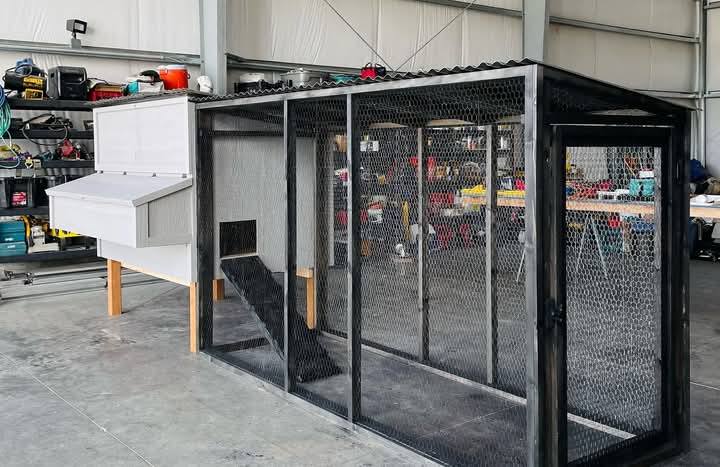
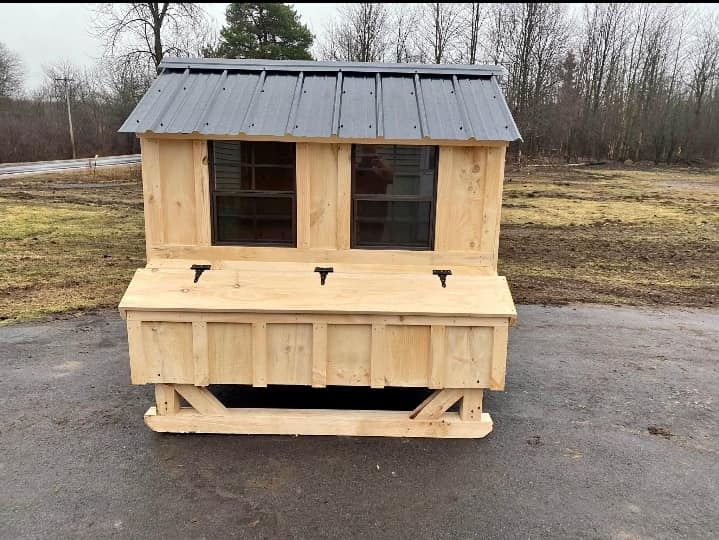


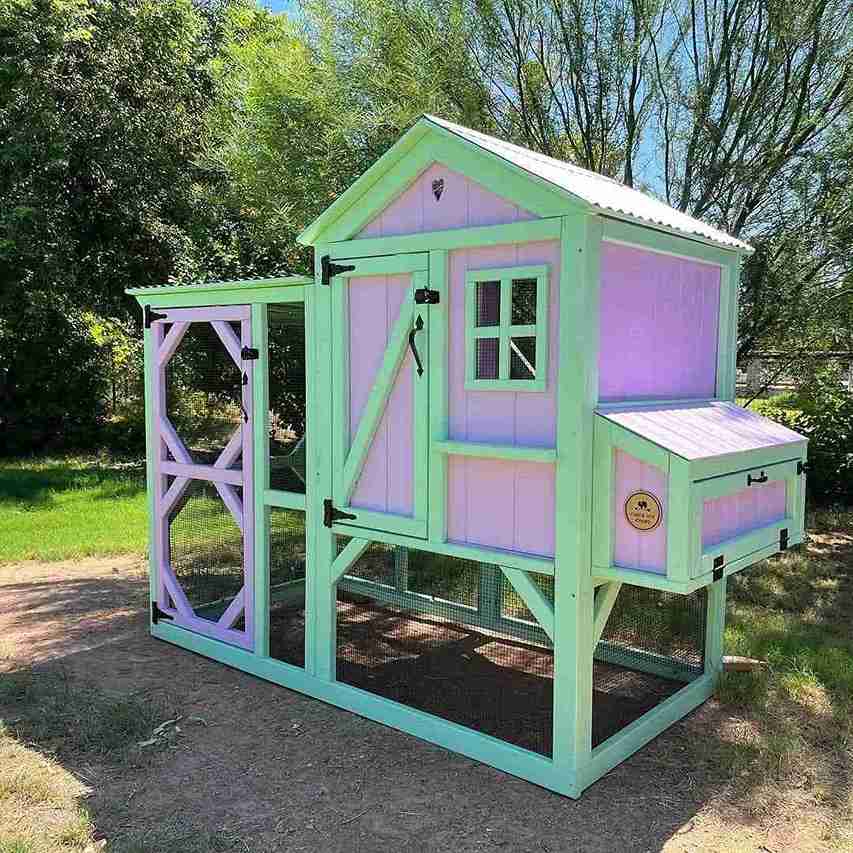
Conclusion
Painting your chicken coop should not be overwhelming and it’s very simple, just choose the best paint, prepare the tools, prepare the coo,p and begin painting the coop.
Ready to give your chicken coop a fresh new look? Share your before-and-after photos with us in the comments below! We’d love to see your creative ideas.
FAQs
What is the best paint for chicken coops?
The best paint for chicken coops is non-toxic, water-based, and VOC-free, such as The Real Milk Paint Co. or ECOS Paints. These are safe for chickens, durable, and eco-friendly, ensuring your flock stays healthy while protecting the coop from weather damage.
Can I use regular house paint?
No, regular house paint often contains toxic chemicals and VOCs harmful to chickens. Always choose non-toxic, animal-safe paints specifically designed for coops to avoid health risks.
How often should I repaint my coop?
Repaint your coop every 2-3 years or when you notice peeling or wear. Frequent repainting maintains protection against weather and pests, ensuring a clean and safe environment for your chickens.
Does painting prevent mites?
Painting doesn’t prevent mites but makes them easier to spot. Light-colored paints, like white, help detect mites quickly, allowing for faster treatment and cleaning.
What’s the best color for a chicken coop?
The best colors are light gray or light blue, as they reflect sunlight, regulate temperature, and create a calming environment for chickens. Avoid bright or dark colors that may stress your flock.
Can I use spray paint on a chicken coop?
No, spray paint contains high levels of VOCs and toxic chemicals, making it unsafe for chickens. Opt for VOC-free, water-based paints for a safer alternative.
Are there specific paint brands for chicken coops?
Yes, top brands include The Real Milk Paint Co., ECOS Paints, and Cuprinol Garden Shades. These offer non-toxic, durable options specifically safe for poultry housing.

Hello! I’m Ibrahim, the owner and writer of this blog. I run a chicken farm with 160 chickens, and I’ve gained a lot of knowledge about raising and caring for them. Now, I want to share my insights and experiences with you to help you in chicken keeping.

